How Platform Capabilities Sustain Business Growth

 If you have been following this series of articles on sustainable business growth, you know that we have arrived at our fourth topic: Platforms. If you missed the previous articles in the series, you can read Article 1 (The Difference Between a Growth Plan and a Growth Engine), Article 2 (Best Practices in Processes) and Article 3 (People and Organizational Best Practices).
If you have been following this series of articles on sustainable business growth, you know that we have arrived at our fourth topic: Platforms. If you missed the previous articles in the series, you can read Article 1 (The Difference Between a Growth Plan and a Growth Engine), Article 2 (Best Practices in Processes) and Article 3 (People and Organizational Best Practices).
You might note that each of these starts with the letter “P.” We’re not trying to be terribly clever, but if you recall your college Marketing 101 class, Marketing was described as “Four P’s.” Time and Marketing have moved on, and these modern day “P’s of Planning, Processes, People, and Platforms all make up a set of best practices for achieving sustainable business growth in today’s competitive environment.
The Role of “Platforms” in Sustaining Growth
There are many uses of the word “platform” today. Our use refers to a set of playbooks, or toolsets, that we believe are companions to engine of growth processes. You could think of them as interactive parts of a growth engine that enable you to consistently and effectively implement and manage growth processes over time and integrate a growth orientation and mindset into your organizational culture.
We have found that in most cases, businesses do not have a standard platform, or playbook, and that makes effective and consistent evaluation and management of growth initiatives unnecessarily challenging.
A robust platform will contain these tools:
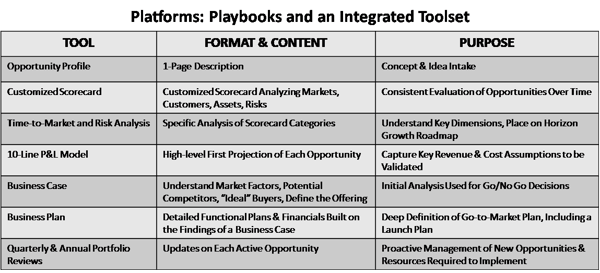
Connecting the Playbook with Best Practice Growth Processes
We’ve already discussed how a healthy approach to sustainable growth comes from connecting best practice growth processes with a best practice playbook comprised of effective tools. Let’s take a more explicit look at how processes and the playbook map together.
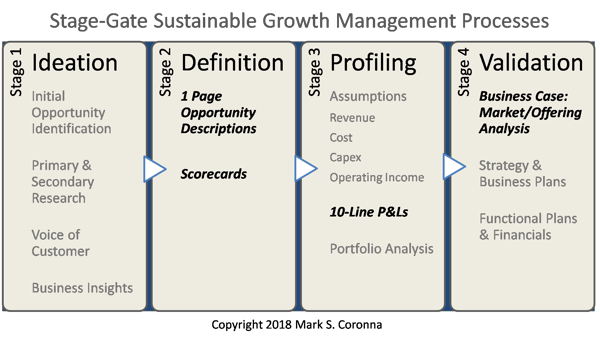
To introduce the relationship between sustainable growth processes and the associated toolset from the playbook, we have called out four of the tools as examples. Let’s look at how they support the consistent implementation of growth processes.
Stage 2/DEFINITION and KEY TOOL: One-Page Opportunity Descriptions
This tool is needed to capture ideas and concepts for new revenue and profit opportunities from anyone who might volunteer one from within your organization. Even better, they can be used to document ideas that prospects and customers might offer.
The goal here is simple: get the idea down on paper and be able to track it over time. This isn’t meant to replace a business case or business plan. It doesn’t have to be more than a one-page description with some (very) early opportunity sizing. All of these one-pagers are evaluated in the Stage 2 process where we evaluate them using a scorecard which we have adapted to the unique needs and characteristics of each business.
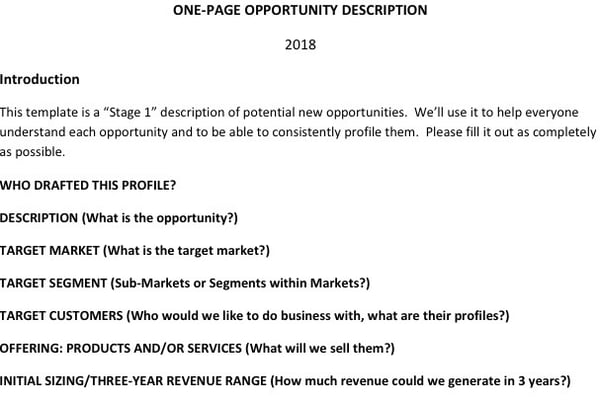
Stage 2/DEFINITION and KEY TOOL: Opportunity Scoring Model
It’s an unnecessary challenge when businesses cannot effectively and consistently compare opportunities with each other and over time. A scorecard promotes the consistent evaluation of opportunities, and supports prioritization and a deep understanding of what timeframe opportunities belong in.
Scorecards usually have six categories and may have 25-30 individual criteria that each opportunity is evaluated against. Typical categories include:
Market Opportunity
Strategic Importance
“Ideal” Customer Profile
Current Capabilities Leverage
Development Cost and Time-to-Market
Business and Technology Risk
Scorecards promote insight across multiple opportunities and are critical to mapping opportunity/time-to-market (which we use to establish revenue stream timelines, and opportunity/risk (which we use to understand whether the match looks acceptable.
Here’s an excerpt of a scorecard set up to score four opportunities:
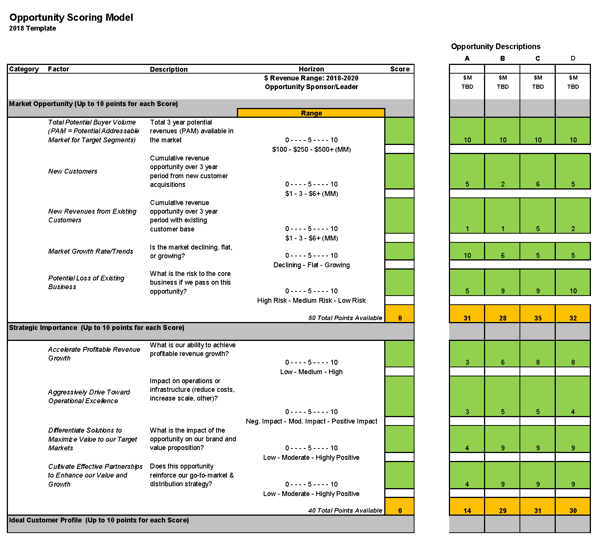
Stage 3/PROFILING and KEY TOOL: Ten (10)-Line P&Ls
The incremental stage-gate approach we recommend is constructed on building out opportunities as more information becomes available through research and validation. Opportunities which achieve high scores on the scorecard, and which have favorable profiles (i.e. large opportunity size and short time-to-market) are usually then evaluated using a brief P&L model.
The key to use of this model is to track revenue and cost assumptions rather than focus solely on the financial numbers which are generated. Those assumptions must be continually validated and this model re-run when additional information is made available. Changes in key assumptions like average order per customer, order frequency, and cost of goods sold can have a material impact on these early financial projections, and its better to understand those early rather than after you have invested significantly in new opportunities.
Here’s a model for a ten-line P&L. Key assumptions should be tracked and linked.
Stage 4/VALIDATION and KEY TOOL: Business Case Including Market & Offering Analysis
A business case is really the first-half of a more comprehensive business plan. There are several excellent reasons to do this in two steps: unless the opportunity and market are better defined, there is too much risk and too much cost and time required to build out a complete business plan. Doing this exercise in two-steps allows the executive team to decide whether the early learning from the business case supports continued opportunity development and investment. Why spend the time and involve a broad set of functional experts in building out a robust business plan when there are key open issues left to understand?
A business case usually has a table of contents like this example. Once it is drafted and reviewed, the executive team can decide whether to add the remaining functional plans, go-to-market plan, and detailed financial plan.

Summary
An effective way to think about Platform best practices used to support the implementation of your growth engine is to think of them as a comprehensive toolset or playbook. These tools work in concert with your growth engine processes to help you consistently manage the identification, scoring, prioritization, financial modeling, business plan development, and ongoing proactive management of new opportunities.
Where to Next?
With this article and the three prior articles, we have described best practices to implementing effective an engine of growth in your business. Here’s what you can expect from the final article in this series:
Topic: Roadmap, Metrics, Benefits
This article will focus on effective adoption of best practices, offer a logical sequence to implementation, and discuss building organizational and program maturity.
Engage with Us!
Do you have ideas to share? Are there some topics that you would like us to address? Give us a call or email us and we’ll be happy to chat with you.
If you want to download a free Growth Champion Position Description, please register here.
Topics: Business Growth Strategy, Revenue Growth, Strategic Planning
Tue, Jun 19, 2018.png?width=1500&height=398&name=CO_Corporate%20Logo%202021_4C_HOR_FNL-1%20(1).png)


